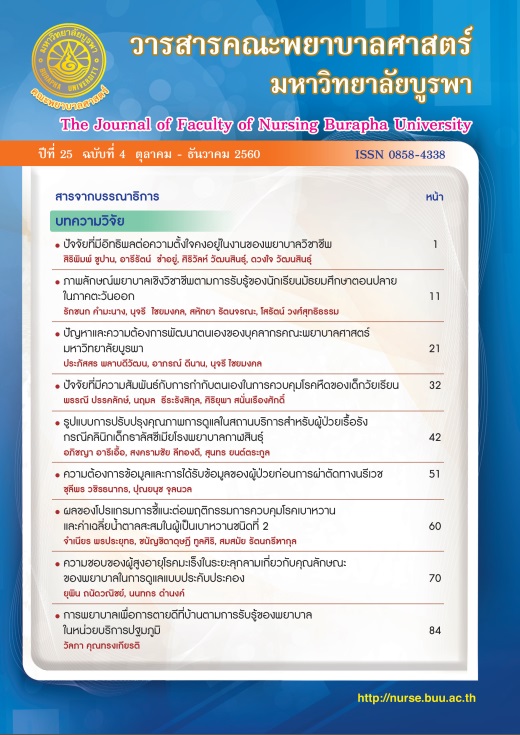ปัจจัยที่มีความสัมพันธ์กับการกำกับตนเองในการควบคุมโรคหืดของเด็ก วัยเรียน
Factors Related to Self-regulation for Asthma Control Among School Age Children
คำสำคัญ:
เด็กวัยเรียน, การกำกับตนเอง, โรคหืด, school-age children, self-regulation, asthmaบทคัดย่อ
การวิจัยครั้งนี้มีวัตถุประสงค์เพื่อศึกษาความสัมพันธ์ระหว่างปัจจัยต่าง ๆ กับการกำกับตนเองในการควบคุมโรคหืดของเด็กวัยเรียน กลุ่มตัวอย่างคัดเลือกโดยวิธีการสุ่มอย่างง่ายเป็นเด็กวัยเรียนโรคหืดอายุ 8 – 12 ปี ที่ เข้ารับการรักษาแผนกผู้ป่วยนอก สถาบันสุขภาพเด็กแห่งชาติมหาราชินี กรุงเทพมหานคร จำนวน 100 ราย เครื่องมือที่ใช้ในการรวบรวมข้อมูลประกอบด้วย แบบสอบถาม ความรู้เกี่ยวกับโรคหืด การรับรู้ความสามารถของตนเองในการควบคุมโรคหืด การรับรู้อาการ การสนับสนุนทางสังคม และการกำกับตนเองในการควบคุมโรคหืดของเด็กวัยเรียน มีค่าความเชื่อมั่นเท่ากับ .79, .76, .73, .82 และ .83 ตามลำดับ วิเคราะห์ข้อมูลด้วยสถิติพรรณนาและสหสัมพันธ์ของเพียร์สัน
ผลการวิจัยพบว่า การสนับสนุนทางสังคม การรับรู้ความสามารถของตนเอง และการรับรู้อาการ มีความสัมพันธ์ทางบวกอย่างมีนัยสำคัญทางสถิติกับการกำกับตนเองของเด็กวัยเรียนโรคหืด (r = .643, p< .001, r = .555, p< .001 และ r = .391, p< .001 ตามลำดับ) ความรู้เกี่ยวกับโรคหืดไม่มีความสัมพันธ์กับการกำกับตนเองของเด็กวัยเรียนโรคหืด (p> .05) ผลการศึกษาครั้งนี้ให้ข้อเสนอแนะว่า พยาบาลเด็กและบุคลากรด้านสุขภาพสามารถนำผลการวิจัยไปใช้เป็นข้อมูลพื้นฐานในการวางแผนโปรแกรมส่งเสริมการกำกับตนเองในการควบคุมโรคหืด โดยเน้นเรื่องการเพิ่มการสนับสนุนทางสังคม การรับรู้ความสามารถของตนเอง และการรับรู้อาการในเด็กวัยเรียนโรคหืด เพื่อให้มีการป้องกันไม่ให้เกิดอาการหอบหืด
-----------------------------------------
This study aimed to examine the relationships between knowledge about factors related to self-regulation for asthma control among school age children. A simple random sampling was used to recruit a sample of 100 school-age children with asthma aged 8 – 12 years and follow up in Out Patient Department at Queen Sirikit National Institute of Child Health, Bangkok. Research instruments included questionnaires of the knowledge about asthma, perceived self-efficacy, perception of symptoms, social support and self-regulation for asthma control among school age children. Their internal consistency reliability were .79, .76, .73, .82 and .83 respectively. Data were analyzed by using descriptive statistics and Pearson’s product moment correlation.
Results revealed that social support, perceived self-efficacy and perception of symptoms were significantly positive relationships with the self-regulation for asthma control among school age children (r = .643, p< .001, r = .555, p< .001 and r = .391, p< .001 respectively). However, there was no significant relationship between the knowledge about asthma and the self-regulation for asthma control among school age children (p > .05). These findings suggested that pediatric nurses and health care providers could obtain these results to utilize for planning an intervention to promote self-regulation for asthma control by focusing on increasing social support, perceived self-efficacy and perception of symptoms in order to asthma control among school-age children for prevent asthma symptoms.
เอกสารอ้างอิง
มหาสารคาม: มหาวิทยาลัยมหาสารคาม.
ณรงค์ หนูสอน. (2553). การส่งเสริมสุขภาพในชุมชนแนวคิดและการปฏิบัติ. (พิมพ์ครั้งที่ 1). กรุงเทพฯ: โรงพิมพ์จุฬาลงกรณ์มหาวิทยาลัย.
ณิชนันท์ อารีย์การเลิศ, ไข่มุกข์ วิเชียรเจริญ, พรศรี ศรีอัษฎาพร และอรทัย พิบูลโภคานันท์. (2553).
การจัดการของผู้ดูแลเกี่ยวกับสิ่งแวดล้อมภายในบ้านที่กระตุ้นให้เกิดอาการหอบในเด็ก
โรคหืด. วารสารพยาบาลศาสตร์, 28(4), 76-85.
นุจรี ไชยมงคล, ยุนี พงศ์จตุรวิทย์ และวณิตา ขวัญสำราญ. (2557). พฤติกรรมสุขภาพในเด็กวัยเรียนและปัจจัยที่เกี่ยวข้อง. วารสารคณะพยาบาลสาสตร์ มหาวิทยาลัยบูรพา. 22(3), 14 - 28.
ปรียานุช นิธิรุ่งเรือง. (2556). ปัจจัยทำนายพฤติกรรมป้องกันอาการภูมิแพ้ในเด็กวัยเรียน. วารสารพยาบาลสาธารณสุข, 27(2), 1-13.
ปิยะนุช จิตตนูนท์. (2553). การดูแลสุขภาพเด็กวัยเรียน: การจัดบริการพยาบาลในโรงเรียน. สงขลา: ลิมบราเดอร์สเพรส.
เปรมฤดี ภูมิถาวร, สุวัฒน์ เบญจพลพิทักษ์, กาญจนา ตั้งนรารัชชกิจ, สุเทพ วาณิชย์กุล และ สุรางค์ เจียมจรรยา. (2552). กุมารเวชศาสตร์สำหรับนักศึกษาแพทย์ เล่มที่1. กรุงเทพฯ: ธนาเพรส.
พิมพ์พญา สมดี. (2558). พฤติกรรมการป้องกันอาการภูมิแพ้ของเด็กวัยเรียนโรคจมูกอักเสบภูมิแพ้และปัจจัยที่เกี่ยวข้อง. วิทยานิพนธ์พยาบาลศาสตรมหาบัณฑิต. พยาบาลศาสตร์. มหาวิทยาลัยบูรพา.
ลักษมี สารบรรณ. (2555). ประสบการณ์อาการหายใจลำบาก การจัดการกับอาการ และผลลัพธ์การจัดการกับอาการในเด็กวัยเรียนโรคหืดของผู้ดูแลเด็ก. วารสารพยาบาลสงขลานครินทร์, 32(2), 23-36.
วรรณา เรืองลาภอนันต์. (2552). ผลกระทบของโรคหืดต่อเด็กป่วยวัยเรียนและครอบครัว.วิทยานิพนธ์พยาบาลศาสตรมหาบัณฑิต. พยาบาลศาสตร์. มหาวิทยาลัยมหิดล.
ศรีเรือน แก้วกังวาล. (2553). จิตวิทยาพัฒนาการทุกช่วงวัย เล่ม1. (พิมพ์ครั้งที่ 9). กรุงเทพฯ: สำนักพิมพ์มหาวิทยาลัยธรรมศาสตร์.
หน่วยงานเวชสถิติ. (2557). สถิติผู้ป่วยเด็กโรคหืด สถาบันสุขภาพเด็กแห่งชาติมหาราชินี ปี พ.ศ. 2557. (CD-ROM). สถาบันสุขภาพเด็กแห่งชาติมหาราชินี.
อาภาวรรณ หนูคง, สุดาภรณ์ พยัคฆเรือง, ยุวดี พงษ์สาระนันทกุล และศิริวรรณ จูฑะพงษ์. (2555). การจัดการของผู้ดูแลในการดูแลเด็กโรคหืด. วารสารสภาการพยาบาล, 30(1), 49-60
อุรารักษ์ ลำน้อย. (2551). ผลของโปรแกรมส่งเสริมการรับรู้สมรรถนะแห่งตน ต่อพฤติกรรมการจัดการตนเองของผู้ป่วยเด็กวัยเรียนโรคหอบหืด. วิทยานิพนธ์พยาบาลศาสตรมหาบัณฑิต. พยาบาลศาสตร์. จุฬาลงกรณ์มหาวิทยาลัย.
American Lung Association. (2012). Trends in Asthma Morbidity and Mortality, Retrieved from http:// www.lung.org.
Bandura, A. (1986). Social foundations of thought and action. New York: Prentice Hall.
Branstetter, A. D., Berg, C. J., Rapoff, M. A., & Belmont, J. M. (2010). Predicting children’s adherence to asthma medication regimens, Journal of Health Behavior and Medicines, 3, 172-185.
Greenley, R. N., Josie, K. L. & Drotar, D. (2006). Perceived involvement in condition management among inner-city youth with asthma and their primary caregivers. Journal of Asthma. 43(9), 687-693.
Guilbert, T. W., Garris, C., Jhingran, P., Bonafede, M., Tomaszewski, K.J., & Bonus, T. (2011). Asthama that is not well-controlled is associated with increased health care utilization and decreased quality of life. The Journal of Asthma. 48(2), 126-132.
House, J. S. (1981). Work stress and social support. California: Addision-Wesley.
Kaul, T. (2011). Helping African-American children self-manage asthma: The importance of self-efficacy. Journal of School Health, 81(1), 29-33.
Mendes, A. et al. (2011). Factors associated with asthma severity in children: A case-control study. The Journal of Asthma, 48(3), 235-240.
Verkleij, M. (2011). Behavioral problems in children and adolescents with difficult-to-treat Asthma. Journal of Asthma, 48(1), 18-24.
Yang, T. O., Sylva, K., & Lunt, I. (2010). Parent Support, Peer Support and Peer Acceptance in Healthy Lifestyle for Asthma Management among Early Adolescents. Journal for Specialists in Pediatric Nursing, 15(4), 272-281.





